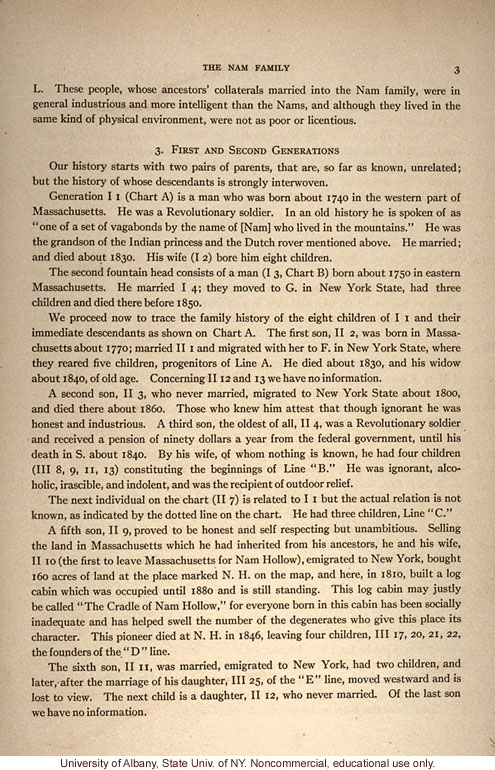The Nam Family 3
L. These people, whose ancestors' collaterals married into the Nam Family, were in general industrious and more intelligent than the Nams, and although they lived in the same kind of physical environment, were not as poor or licentious.
3. First and Second Generations
Our history starts with two pairs of parents, that are, so far as known, unrelated; but the history of whose descendants is strongly interwoven.
Generation I [small cap]I[end small cap] (Chart A) is a man who was born about 1740 in the western part of Massachusetts. He was a Revolutionary soldier. In an old history he is spoken of as "one of a set of vagabonds by the name of [open bracket]Nam[close bracket] who lived in the mountains." He was the grandson of the Indian princess and the Dutch rover mentioned above. He married; and died about 1830. His wife (I 2) bore him eight children.
The second family head consists of a man (I 3, Chart B) born about 1750 in eastern Massachusetts. He married I 4; they moved to G. in New York State, had three children and died there before 1850.
We proceed now to trace the family history of the eight children of I [small cap]I[end small cap] and their immediate descendants as shown in Chart A. The first son, II 2, was born in Massachusetts about 1770; married II I and migrated with her to F. in New York State, where they reared five children, progenitors of Line A. He died about 1830, and his widow about 1840, of old age. Concerning II 12 and 13 we have no information.
A second son, II 3, who never married, migrated to New York State about 1800, and died there about 1860. Those who knew him attest that though ignorant he was honest and industrious. A third son, the oldest of all, II 4, was a Revolutionary soldier and received a pension of ninety dollars a year from the federal government, until his death in S. about 1840. By his wife, of whom nothing is known, he had four children (III 8, 9, 11, 13) constituting the beginnings of Line "B." He was ignorant, alcoholic, irascible, and indolent, and was the recipient of outdoor relief.
The next individual on the chart (II 7) is related to I [small cap]I[end small cap] but the actual relation is not known, as indicated by the dotted line on the chart. He had three children, Line "C".
A fifth son, II 9, proved to be honest and self respecting but unambitious. Selling the land in Massachusetts which he had inherited from his ancestors, he and his wife, II 10 (the first to leave Massachusetts for Nam Hollow), emigrated to New York, bought 160 acres of land at the place marked N. H. on the map, and here, in 1810, built a log cabin which was occupied until 1880 and is still standing. This log cabin may justly be called "The Cradle of Nam Hollow," for everyone born in this cabin has been socially inadequate and has helped swell the number of the degenerates who give this place its character. This pioneer died at N. H. in 1846, leaving four children, III 17, 20, 21, 22, the founders of the "D" line.
The sixth son, II [small caps]II[end small caps], was married, emigrated to New York, had two children, and later, after the marriage of his daughter, III 25, of the "E" line, moved westward and is lost to view. The next child is a daughter, II 12, who never married. Of the last son we have no information. [end]


